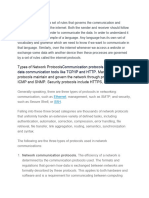0% found this document useful (0 votes)
48 views2 pagesProtocols
The document outlines various network protocols that establish rules for data communication between computer devices. Key protocols include TCP for packet transmission, IP for addressing, UDP for low-latency communication, and others like POP, SMTP, FTP, HTTP, HTTPS, Telnet, and Gopher for specific functions such as email handling, file transfer, and secure web communication. Each protocol serves a distinct purpose in ensuring effective and secure data exchange across networks.
Uploaded by
MaqboolCopyright
© © All Rights Reserved
We take content rights seriously. If you suspect this is your content, claim it here.
Available Formats
Download as PDF, TXT or read online on Scribd
0% found this document useful (0 votes)
48 views2 pagesProtocols
The document outlines various network protocols that establish rules for data communication between computer devices. Key protocols include TCP for packet transmission, IP for addressing, UDP for low-latency communication, and others like POP, SMTP, FTP, HTTP, HTTPS, Telnet, and Gopher for specific functions such as email handling, file transfer, and secure web communication. Each protocol serves a distinct purpose in ensuring effective and secure data exchange across networks.
Uploaded by
MaqboolCopyright
© © All Rights Reserved
We take content rights seriously. If you suspect this is your content, claim it here.
Available Formats
Download as PDF, TXT or read online on Scribd
/ 2
























































































